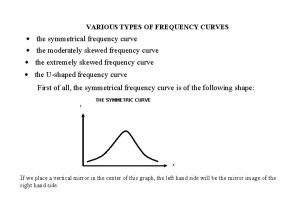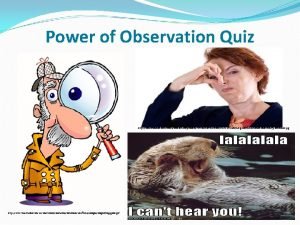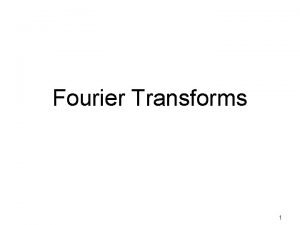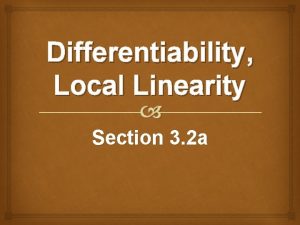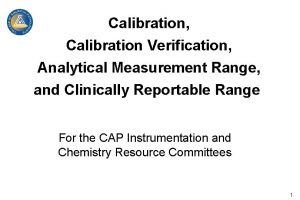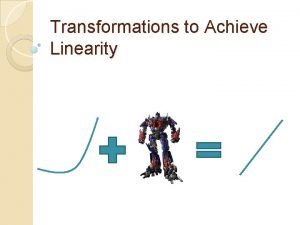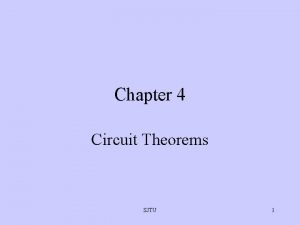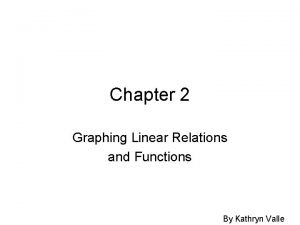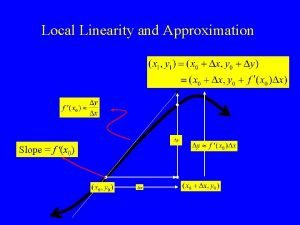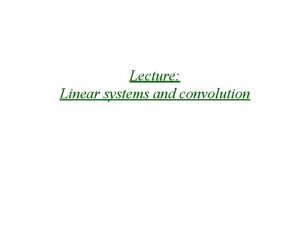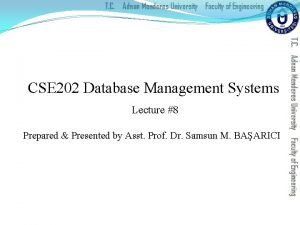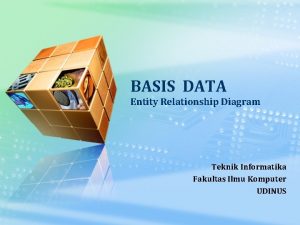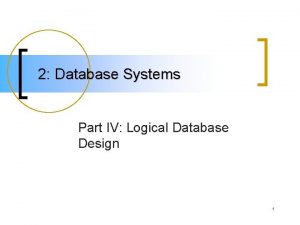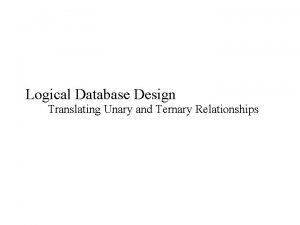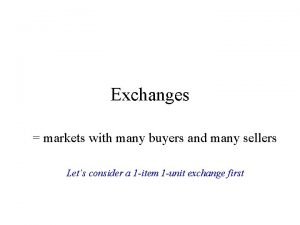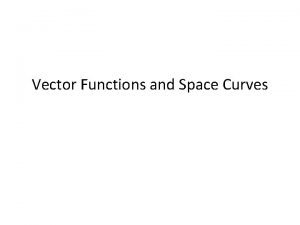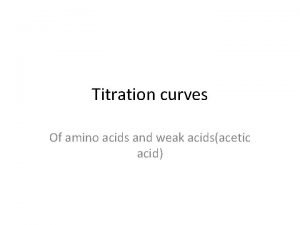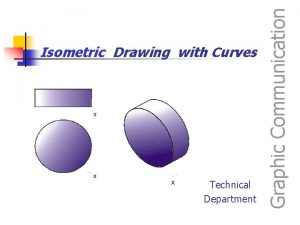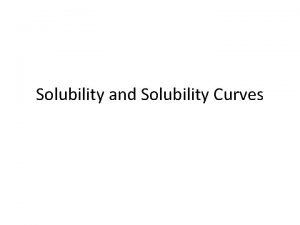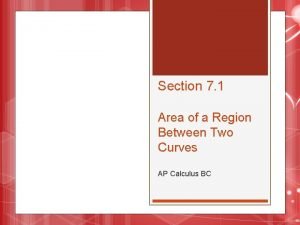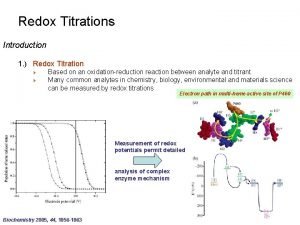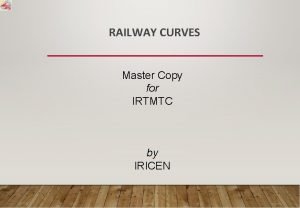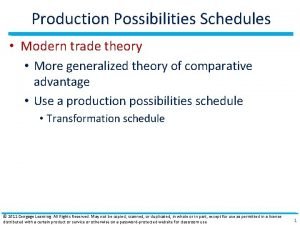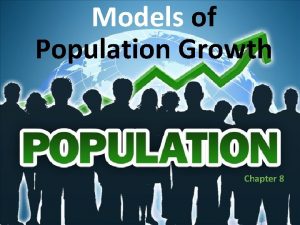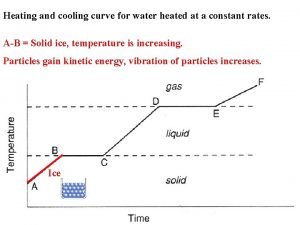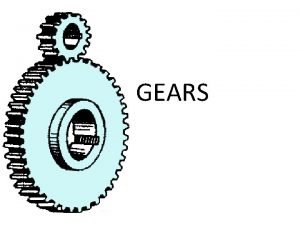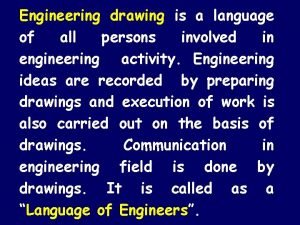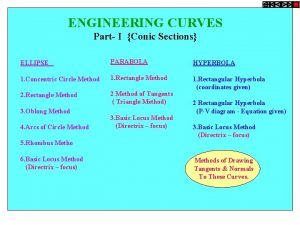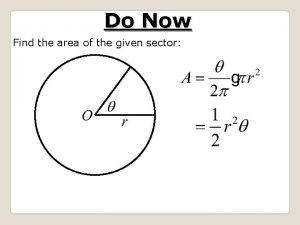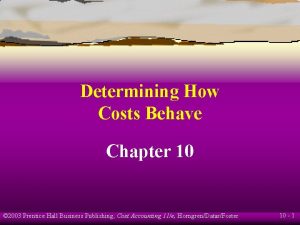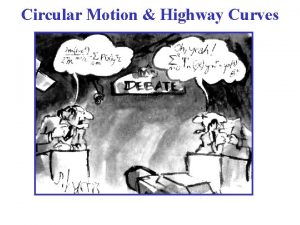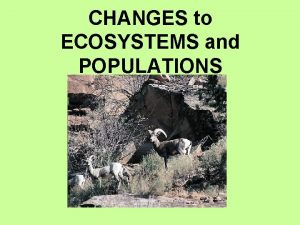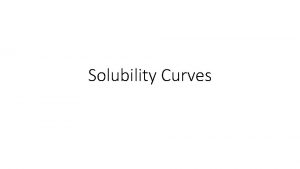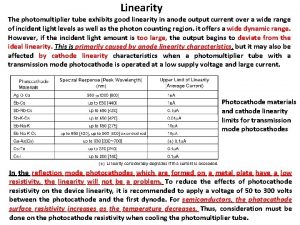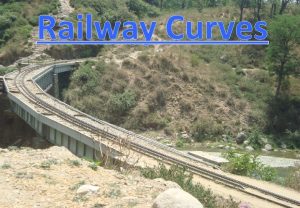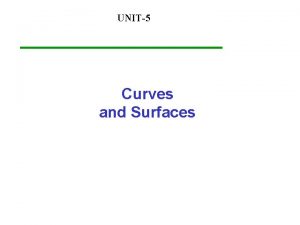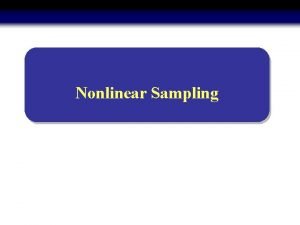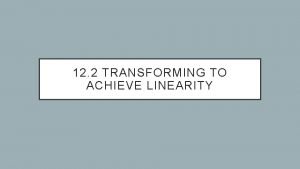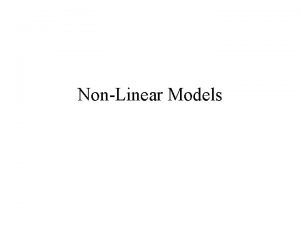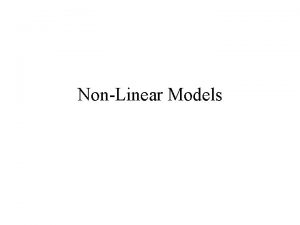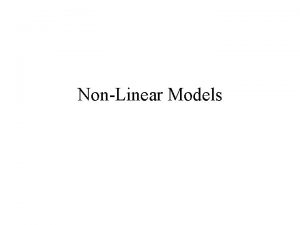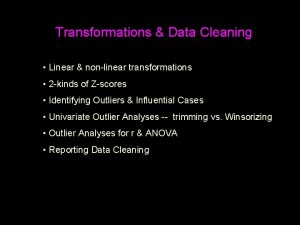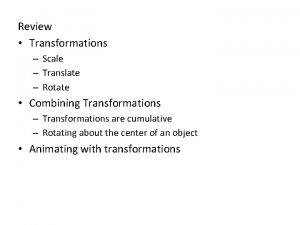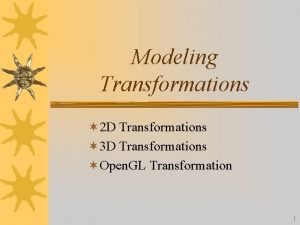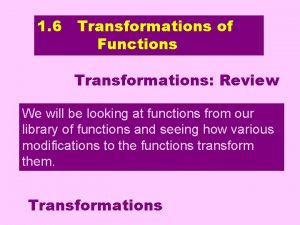Transformations Transformations to Linearity Many nonlinear curves can












































- Slides: 44

Transformations

Transformations to Linearity • Many non-linear curves can be put into a linear form by appropriate transformations of the either – the dependent variable Y or – some (or all) of the independent variables X 1, X 2, . . . , Xp. • This leads to the wide utility of the Linear model. • We have seen that through the use of dummy variables, categorical independent variables can be incorporated into a Linear Model. • We will now see that through the technique of variable transformation that many examples of non -linear behaviour can also be converted to linear behaviour.

Intrinsically Linear (Linearizable) Curves 1 Hyperbolas y = x/(ax-b) Linear form: 1/y = a -b (1/x) or Y = b 0 + b 1 X Transformations: Y = 1/y, X=1/x, b 0 = a, b 1 = -b

2. Exponential y = a ebx = a. Bx Linear form: ln y = lna + b x = lna + ln. B x or Y = b 0 + b 1 X Transformations: Y = ln y, X = x, b 0 = lna, b 1 = b = ln. B

3. Power Functions y = a xb Linear from: ln y = lna + blnx or Y = b 0 + b 1 X

Logarithmic Functions y = a + b lnx Linear from: y = a + b lnx or Y = b 0 + b 1 X Transformations: Y = y, X = ln x, b 0 = a, b 1 = b

Other special functions y = a e b/x Linear from: ln y = lna + b 1/x or Y = b 0 + b 1 X Transformations: Y = ln y, X = 1/x, b 0 = lna, b 1 = b

Polynomial Models y = b 0 + b 1 x + b 2 x 2 + b 3 x 3 Linear form Y = b 0 + b 1 X 1 + b 2 X 2 + b 3 X 3 Variables Y = y, X 1 = x , X 2 = x 2, X 3 = x 3

Exponential Models with a polynomial exponent Linear form lny = b 0 + b 1 X 1 + b 2 X 2 + b 3 X 3+ b 4 X 4 Y = lny, X 1 = x , X 2 = x 2, X 3 = x 3, X 4 = x 4

Trigonometric Polynomial Models y = b 0 + g 1 cos(2 pf 1 x) + d 1 sin(2 pf 1 x) + … + gkcos(2 pfkx) + dksin(2 pfkx) Linear form Y = b 0 + g 1 C 1 + d 1 S 1 + … + gk Ck + dk Sk Variables Y = y, C 1 = cos(2 pf 1 x) , S 2 = sin(2 pf 1 x) , … Ck = cos(2 pfkx) , Sk = sin(2 pfkx)

Response Surface models Dependent variable Y and two independent variables x 1 and x 2. (These ideas are easily extended to more the two independent variables) The Model (A cubic response surface model) or Y = b 0 + b 1 X 1 + b 2 X 2 + b 3 X 3 + b 4 X 4 + b 5 X 5 + b 6 X 6 + b 7 X 7 + b 8 X 8 + b 9 X 9+ e where


The Box-Cox Family of Transformations

The Transformation Staircase

The Bulging Rule y up x down x up y down

Non-Linear Models Nonlinearizable models

Non-Linear Growth models • many models cannot be transformed into a linear model The Mechanistic Growth Model Equation: or (ignoring e) “rate of increase in Y” =

The Logistic Growth Model Equation: or (ignoring e) “rate of increase in Y” =

The Gompertz Growth Model: Equation: or (ignoring e) “rate of increase in Y” =

Example: daily auto accidents in Saskatchewan to 1984 to 1992 Data collected: 1. Date 2. Number of Accidents Factors we want to consider: 1. Trend 2. Yearly Cyclical Effect 3. Day of the week effect 4. Holiday effects

Trend This will be modeled by a Linear function : Y = b 0 +b 1 X (more generally a polynomial) Y = b 0 +b 1 X +b 2 X 2 + b 3 X 3 + …. Yearly Cyclical Trend This will be modeled by a Trig Polynomial – Sin and Cos functions with differing frequencies(periods) : Y = d 1 sin(2 pf 1 X) + g 1 cos(2 pf 2 X) + d 1 sin(2 pf 2 X) + g 2 cos(2 pf 2 X) + …

Day of the week effect: This will be modeled using “dummy”variables : a 1 D 1 + a 2 D 2 + a 3 D 3 + a 4 D 4 + a 5 D 5 + a 6 Di = (1 if day of week = i, 0 otherwise) Holiday Effects Also will be modeled using “dummy”variables :

Independent variables X = day, D 1, D 2, D 3, D 4, D 5, D 6, S 1, S 2, S 3, S 4, S 5, S 6, C 1, C 2, C 3, C 4, C 5, C 6, NYE, HW, V 1, V 2, cd, T 1, T 2. Si=sin(0. 017202423838959*i*day). Ci=cos(0. 017202423838959*i*day). Dependent variable Y = daily accident frequency

Independent variables ANALYSIS OF VARIANCE SUM OF SQUARES DF MEAN SQUARE F RATIO REGRESSION 976292. 38 18 54238. 46 114. 60 RESIDUAL 1547102. 1 3269 473. 2646 VARIABLES IN EQUATION FOR PACC VARIABLES NOT IN EQUATION STD. ERROR STD REG F . PARTIAL F VARIABLE COEFFICIENT OF COEFF TOLERANCE TO REMOVE LEVEL. VARIABLE CORR. TOLERANCE TO ENTER LEVEL (Y-INTERCEPT 60. 48909 ) . day 1 0. 11107 E-02 0. 4017 E-03 0. 038 0. 99005 7. 64 1. IACC 7 0. 49837 0. 78647 1079. 91 0 D 1 9 4. 99945 1. 4272 0. 063 0. 57785 12. 27 1. Dths 8 0. 04788 0. 93491 7. 51 0 D 2 10 9. 86107 1. 4200 0. 124 0. 58367 48. 22 1. S 3 17 -0. 02761 0. 99511 2. 49 1 D 3 11 9. 43565 1. 4195 0. 119 0. 58311 44. 19 1. S 5 19 -0. 01625 0. 99348 0. 86 1 D 4 12 13. 84377 1. 4195 0. 175 0. 58304 95. 11 1. S 6 20 -0. 00489 0. 99539 0. 08 1 D 5 13 28. 69194 1. 4185 0. 363 0. 58284 409. 11 1. C 6 26 -0. 02856 0. 98788 2. 67 1 D 6 14 21. 63193 1. 4202 0. 273 0. 58352 232. 00 1. V 1 29 -0. 01331 0. 96168 0. 58 1 S 1 15 -7. 89293 0. 5413 -0. 201 0. 98285 212. 65 1. V 2 30 -0. 02555 0. 96088 2. 13 1 S 2 16 -3. 41996 0. 5385 -0. 087 0. 99306 40. 34 1. cd 31 0. 00555 0. 97172 0. 10 1 S 4 18 -3. 56763 0. 5386 -0. 091 0. 99276 43. 88 1. T 1 32 0. 00000 0. 00 1 C 1 21 15. 40978 0. 5384 0. 393 0. 99279 819. 12 1. C 2 22 7. 53336 0. 5397 0. 192 0. 98816 194. 85 1. C 3 23 -3. 67034 0. 5399 -0. 094 0. 98722 46. 21 1. C 4 24 -1. 40299 0. 5392 -0. 036 0. 98999 6. 77 1. C 5 25 -1. 36866 0. 5393 -0. 035 0. 98955 6. 44 1. NYE 27 32. 46759 7. 3664 0. 061 0. 97171 19. 43 1. HW 28 35. 95494 7. 3516 0. 068 0. 97565 23. 92 1. T 2 33 -18. 38942 7. 4039 -0. 035 0. 96191 6. 17 1. ***** F LEVELS( 4. 000, 3. 900) OR TOLERANCE INSUFFICIENT FOR FURTHER STEPPING

Day of the week effects D 1 4. 99945 D 2 9. 86107 D 3 9. 43565 D 4 13. 84377 D 5 28. 69194 D 6 21. 63193


Holiday Effects NYE HW T 2 32. 46759 35. 95494 -18. 38942

Cyclical Effects S 1 S 2 S 4 C 1 C 2 C 3 C 4 C 5 -7. 89293 -3. 41996 -3. 56763 15. 40978 7. 53336 -3. 67034 -1. 40299 -1. 36866


Transformations to Linearity • Many non-linear curves can be put into a linear form by appropriate transformations of the either – the dependent variable Y or – some (or all) of the independent variables X 1, X 2, . . . , Xp. • This leads to the wide utility of the Linear model. • We have seen that through the use of dummy variables, categorical independent variables can be incorporated into a Linear Model. • We will now see that through the technique of variable transformation that many examples of non -linear behaviour can also be converted to linear behaviour.

Intrinsically Linear (Linearizable) Curves 1 Hyperbolas y = x/(ax-b) Linear form: 1/y = a -b (1/x) or Y = b 0 + b 1 X Transformations: Y = 1/y, X=1/x, b 0 = a, b 1 = -b

2. Exponential y = a ebx = a. Bx Linear form: ln y = lna + b x = lna + ln. B x or Y = b 0 + b 1 X Transformations: Y = ln y, X = x, b 0 = lna, b 1 = b = ln. B

3. Power Functions y = a xb Linear from: ln y = lna + blnx or Y = b 0 + b 1 X

Logarithmic Functions y = a + b lnx Linear from: y = a + b lnx or Y = b 0 + b 1 X Transformations: Y = y, X = ln x, b 0 = a, b 1 = b

Other special functions y = a e b/x Linear from: ln y = lna + b 1/x or Y = b 0 + b 1 X Transformations: Y = ln y, X = 1/x, b 0 = lna, b 1 = b

Polynomial Models y = b 0 + b 1 x + b 2 x 2 + b 3 x 3 Linear form Y = b 0 + b 1 X 1 + b 2 X 2 + b 3 X 3 Variables Y = y, X 1 = x , X 2 = x 2, X 3 = x 3

Exponential Models with a polynomial exponent Linear form lny = b 0 + b 1 X 1 + b 2 X 2 + b 3 X 3+ b 4 X 4 Y = lny, X 1 = x , X 2 = x 2, X 3 = x 3, X 4 = x 4

Trigonometric Polynomials

• b 0, d 1, g 1, … , dk, gk are parameters that have to be estimated, • n 1, n 2, n 3, … , nk are known constants (the frequencies in the trig polynomial. Note:

Response Surface models Dependent variable Y and two independent variables x 1 and x 2. (These ideas are easily extended to more the two independent variables) The Model (A cubic response surface model) or Y = b 0 + b 1 X 1 + b 2 X 2 + b 3 X 3 + b 4 X 4 + b 5 X 5 + b 6 X 6 + b 7 X 7 + b 8 X 8 + b 9 X 9+ e where


The Box-Cox Family of Transformations

The Transformation Staircase

The Bulging Rule y up x down x up y down
 Types of frequency curve
Types of frequency curve On which playing card is the cardmaker's trademark
On which playing card is the cardmaker's trademark Fourier transformation equation
Fourier transformation equation Local linearity
Local linearity Amr vs linearity
Amr vs linearity Transforming to achieve linearity
Transforming to achieve linearity Linearity property circuits
Linearity property circuits 2-2 linear relations and functions
2-2 linear relations and functions Local linearity formula
Local linearity formula Linearity property
Linearity property Convolution linearity
Convolution linearity Hotstuff bft
Hotstuff bft Combined transformations
Combined transformations Many sellers and many buyers
Many sellers and many buyers Er diagram many to many
Er diagram many to many Convert conceptual model to logical model
Convert conceptual model to logical model Are the glue that holds the entities in the erd
Are the glue that holds the entities in the erd Unary many to many
Unary many to many Erd film
Erd film Unary many to many
Unary many to many Many-to-many communication
Many-to-many communication Sqlbi many to many
Sqlbi many to many Unary relationship database
Unary relationship database Many sellers and many buyers
Many sellers and many buyers Vector function and space curves
Vector function and space curves Amino acid titration curves
Amino acid titration curves Isometric drawing curves
Isometric drawing curves Zoological riddles challenge
Zoological riddles challenge What are solutions
What are solutions Area between two curves formula
Area between two curves formula Redox titration curve innvolves
Redox titration curve innvolves Speed on curves iricen
Speed on curves iricen Creating production possibilities schedules and curves
Creating production possibilities schedules and curves S and j curves
S and j curves Curved outward mirror
Curved outward mirror Titration curve of amino acids
Titration curve of amino acids Curves of intersection in engineering drawing
Curves of intersection in engineering drawing Latent heat of fusion
Latent heat of fusion Interference in gears
Interference in gears Engineering drawing curves
Engineering drawing curves Engineering curves
Engineering curves Area of polar curves practice
Area of polar curves practice Learning curves 2003
Learning curves 2003 Highway curves banked and unbanked
Highway curves banked and unbanked S and j curves
S and j curves
